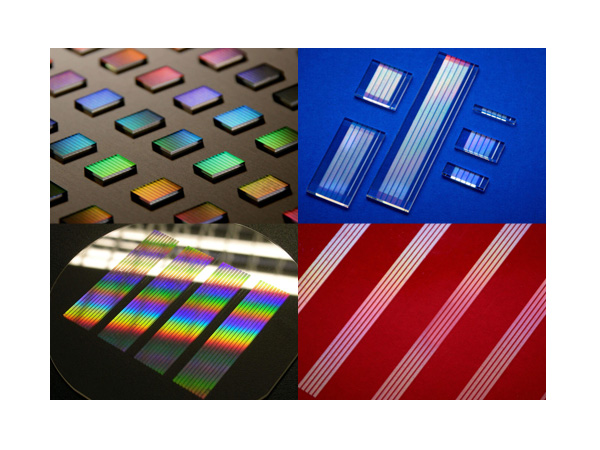
MgO:PPLN for efficient wavelength conversion Adding 5% magnesium-oxide to lithium niobate significantly increases the optical and photorefractive resistance of the crystal while preserving its high nonlinear coefficient. This allows more stable operat
Our new waveguide delivers market leading performance combined with easy to use FC/APC input and outputs. The main features include diced ridge structures in MgO:PPLN, pump wavelength range from stock: 1535nm to 1565nm, available in chip and packaged formats, fiber in/out package with integrated heater unit for thermal tuning, temperature control units available and we can customize wavelength. Please contact us with your specification to discuss availability and pricing.
Dimensions:
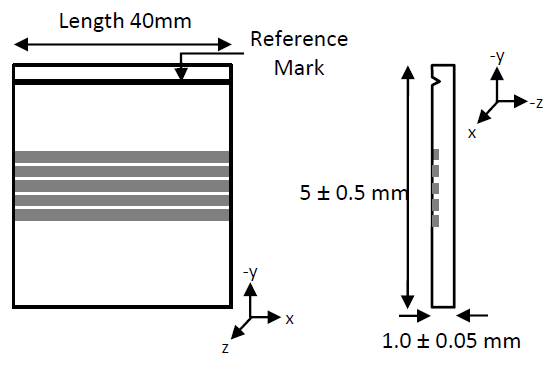
Side view:
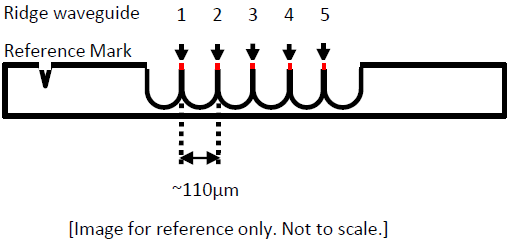
SEM photograph of ridge waveguide
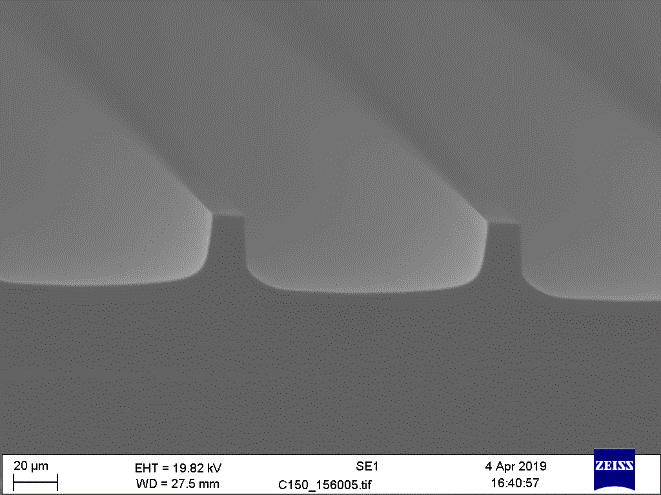
Top view of chip layout with butt coupled fibre launch
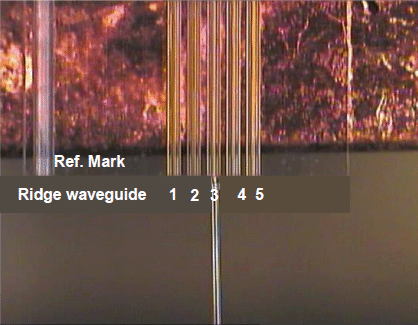
Set-up for lensed launch testing
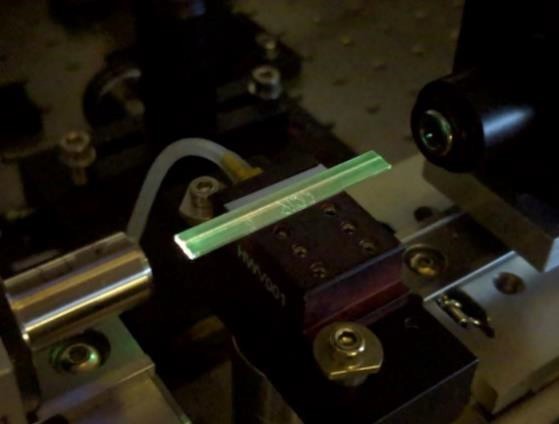
| AR coated SHG waveguide chip | |
| Waveguide length [mm] | 40 |
| Available pump wavelength by chip selection [nm] | 1535-1565 |
| Temperature tuning Coeff. [nm/°C] | 0.15 |
| Standard temperature tuning range [°C] | 50 +/- 20 |
| CW pump launch [mW] | 300 |
| Coupling efficiency [%] | 75 +/- 5 |
| CW SHG output [mW] | 40 +/- 5 |
| Typical efficiency [%/W] | 45 |
| Waveguide NA and ωo [µm] (@1.56µm) | 0.12 / 4.5 |
Waveguide dimensions:
Substrate Thickness(z) 1.0mm±0.05mm
Substrate Width(y) 5mm±0.2mm
Waveguide Chip Length(x) 40mm±0.5mm
Features:
The SHG device base material is 5% Magnesium doped Lithium Niobate
A Zinc indiffused planar layer and diced ridge structures define the waveguides
Typical coupling efficiencies with a lensed launch: ~75%
Launch fibre for tests: OzOptics PMF-1550-8/125-0.25-L (MFD 10.5 µm)
Set-up for lensed Launch, Thorlabs lens: Zoom collimator C220-TMD-B; Aspheric focusing: C560-TME-C
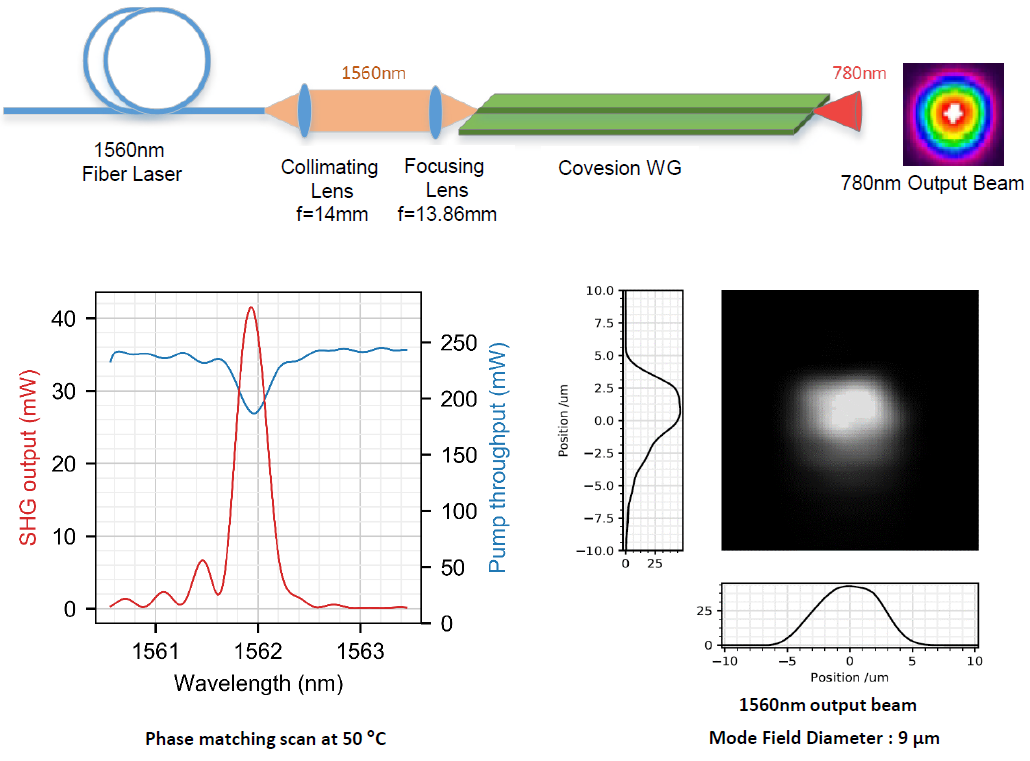
The following waveguide is packaged, designed to meet different experiemtal setup requirements from customers.
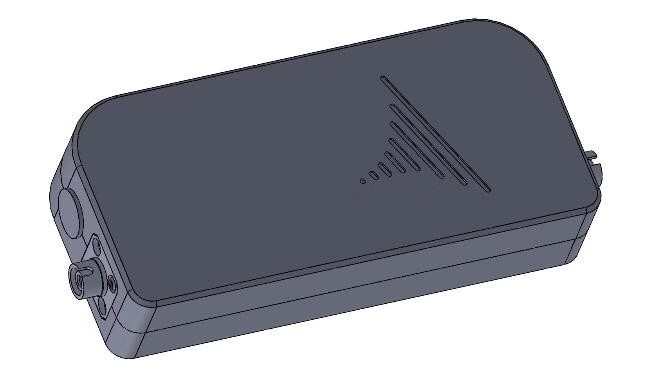
Dimension : 112x40x24mm
SEM photograph of waveguide
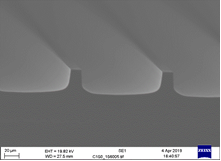
| Packaged waveguide specification | |
| Center wavelength by chip selection [nm] | 1535-1565 |
| Temperature tuning Coeff. [nm/°C] | 0.15 |
| Temperature tuning range from ambient [°C] | 30 to 70 |
| CW pump launch [mW] | 300 |
| CW SHG output [mW] | 35 +/- 5 |
| Typical efficiency [%/W] | 40 |
| Fiber connector | PM-FC-APC |
| Weight [g] | 345 |
| Dimension [mm] | 112 x 52 x 24 |
MgO:PPLN for efficient wavelength conversion
Adding 5% magnesium-oxide to lithium niobate significantly increases the optical and photorefractive resistance of the crystal while preserving its high nonlinear coefficient. This allows more stable operation at visible wavelengths and lower temperature operation than a similar undoped crystal. MgO:PPLN can be operated at temperatures as low as room temperature and in some cases, without temperature stabilisation. With temperatures from ambient up to 200°C, MgO:PPLN offers significantly wider wavelength operation than undoped PPLN.
Specially developed for red-green-blue generation and high power mid-IR operation, our proprietary MgO:PPLN poling process offers high fidelity periods from 4.5μm to 33μm+ and is ideal for volume manufacture. As shown below, our MgO:PPLN domains are poled through the entire thickness of the sample, providing maximum optical aperture.
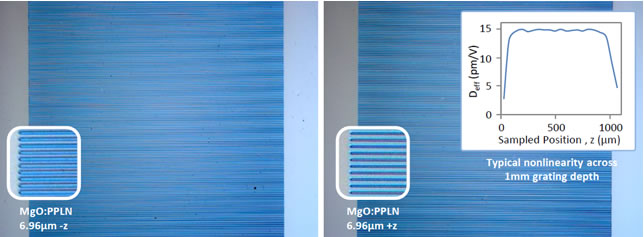
Our MgO:PPLN crystals are designed to work with a wide range of common laser wavelengths. Each off-the-shelf device includes multiple gratings for flexible temperature and wavelength operation. MgO:PPLN has a wide operating temperature range from 30-200°C.
Crystal lengths are 0.3mm to 1mm for short-pulse femtosecond lasers and 10mm to 40mm for ns to CW systems. Our standard crystals are supplied clip-mounted and off-the-shelf. Custom crystal lengths, thicknesses, AR coatings, and grating designs are also available upon request.
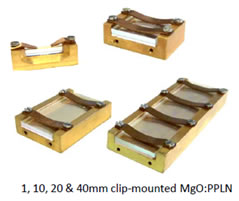

Pictorial representation of a PPLN grating where laser light focused into the grating is converted to another wavelength. This can be achieved with the correct poling period, crystal temperature, and z-axis polarization.
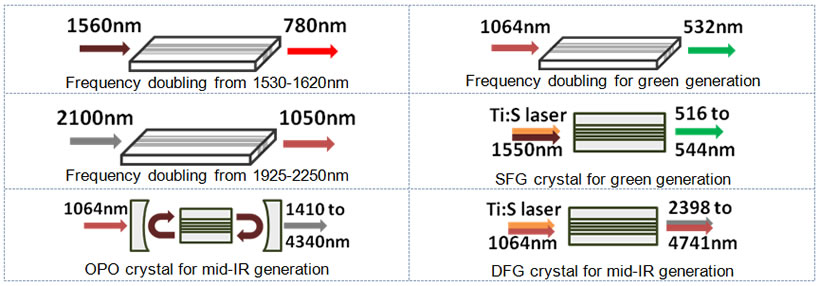
MgO:PPLN for SHG: visible and near-IR wavelengths
Second Harmonic Generation:
High efficiency frequency doubling of IR lasers to visible and shorter near-IR wavelengths
Available in 0.5mm and 1.0mm apertures
Mounted and double-band AR coated
Applications:
Green and blue generation
Scientific & medical
Frequency comb stability
Fluorescence microscopy
Our SHG MgO:PPLN crystals are designed to work with a wide range of common laser wavelengths. Each device has several gratings to allow phase matching at different temperatures. The visible wavelength devices contain multiple gratings designed for phase matching of the nominal pump wavelength typically between 30-200°C. Tuning to temperatures up to 200°C allows phase matching to longer wavelengths. All of our products undergo rigorous quality inspection and are supplied clip-mounted and off-the-shelf. Custom crystal lengths, thicknesses, AR coatings, and grating designs are also available upon request
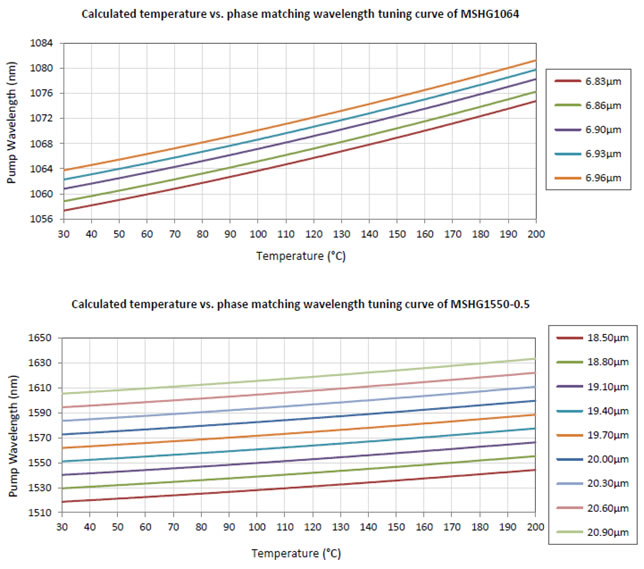
| part # | pump (nm) | output (nm) | grating periods (µm) | temperature tuning range (°C) | thickness (mm) | standard* lengths (mm) |
| STCS-MSHG976-0.5 | 976 (970 – 992) | 488 (485 – 496) | 5.17, 5.20, 5.23, 5.26, 5.29 | 30 – 200 | 0.5 | 1, 3, 5, 10, 20 |
| STCS-MSHG1020-1.0 | 1020 (1006-1036) | 510 (503-518) | 5.84, 5.98, 6.08 | 30 – 200 | 1.0 | 1, 3, 5, 10, 20, 40 |
| STCS-MSHG1030-0.5 | 1030 (1024 – 1047) | 515 (512 – 524) | 6.16, 6.19, 6.23, 6.26, 6.29 | 30 – 200 | 0.5 | 1, 3, 5, 10, 20, 40 |
| STCS-MSHG1047-0.5 | 1047 (1040 – 1064) | 523.5 (520 – 532) | 6.48, 6.52, 6.55, 6.59, 6.62 | 30 – 200 | 0.5 | 1, 3, 5, 10, 20, 40 |
| STCS-MSHG1064-0.5 | 1064 (1058 – 1080) | 532 (529 – 540) | 6.83, 6.86, 6.90, 6.93, 6.96 | 30 – 200 | 0.5 | 1, 3, 5, 10, 20, 40 |
| STCS-MSHG1064-1.0 | 1064 (1058 – 1080) | 532 (529 – 540) | 6.83, 6.86, 6.90, 6.93, 6.96 | 30 – 200 | 1.0 | 1, 3, 5, 10, 20, 40 |
| STCS-MSHG1080-0.5 | 1080 (1060-1116) | 540 (530-558) | 6.90, 7.10, 7.30, 7.50, 7.70 | 30 – 200 | 0.5 | 1, 3, 5, 10, 20, 40 |
| STCS-MSHG1120-1.0 | 1120 (1106-1158) | 560 (553-579) | 7.87, 7.99, 8.11, 8.23, 8.35, 8.47, 8.59 | 30 – 200 | 1.0 | 1, 3, 5, 10, 20, 40 |
| STCS-MSHG1180-0.5 | 1180 (1166-1220) | 590 (583-610) | 9.20, 9.40, 9.60, 9.80, 10.00 | 30 – 200 | 0.5 | 1, 3, 5, 10, 20, 40 |
| STCS-MSHG1230-0.5 | 1230 (1216-1262) | 615 (608-631) | 10.40, 10.55, 10.70, 10.85, 11.00 | 30 – 200 | 0.5 | 1, 3, 5, 10, 20, 40 |
| STCS-MSHG1320-0.5 | 1320 (1284-1336) | 660 (642-668) | 12.10, 12.30, 12.50, 12.70, 12.90 | 30 – 200 | 0.5 | 1, 3, 5, 10, 20, 40 |
| STCS-MSHG1350-0.5 | 1350 (1296-1422) | 675 (648-711) | 12.40, 12.80, 13.20, 13.60, 14.00, 14.40, 14.80, 15.20 | 30 – 200 | 0.5 | 1, 3, 5, 10, 20, 40 |
| STCS-MSHG1420-0.5 | 1420 (1350-1490) | 710 (675-745) | 13.83, 13.96,14.08, 14.55, 15.10, 15.60, 16.10, 16.60, 17.10 | 30 – 200 | 0.5 | 1, 3, 5, 10, 20, 40 |
| STCS-MSHG1550-0.5 | 1550 (1530 – 1620) | 775 (765 – 810) | 18.50, 18.80, 19.10, 19.40, 19.70, 20.00, 20.30, 20.60, 20.90 | 30 – 200 | 0.5 | 0.3, 0.5, 1, 3, 5, 10, 20, 40 |
| STCS-MSHG1550-1.0 | 1550 (1545 – 1610) | 775 (773 – 805) | 19.20, 19.50, 19.80, 20.10, 20.40 | 30 – 200 | 1.0 | 1, 3, 5, 10, 20, 40 |
| STCS-MSHG1650-0.5 | 1650 (1605 – 1720) | 825 (803 – 860) | 20.90, 21.20, 21.50, 21.80, 22.10, 22.40, 22.70, 23.00, 23.30 | 30 – 200 | 0.5 | 1, 3, 5, 10, 20, 40 |
| STCS-MSHG2100-0.5 | 2100 (1925-2270) | 1050 (963-1135) | 28.40, 29.00, 29.60, 30.20, 30.80, 31.40, 32.00, 32.60, 33.20 | 30 – 200 | 0.5 | 1, 3, 5, 10, 20, 40 |
| STCS-MSHG2100-1.0 | 2100 (1968-2270) | 1050 (984-1135) | 29.60, 30.20, 30.80, 31.40, 32.00, 32.60, 33.20 | 30 – 200 | 1.0 | 1, 3, 5, 10, 20, 40 |
| STCS-MSHG2600-1.0 | 2600 (2260-3300) | 1300 (1130-1650) | 34.00, 34.80, 35.50, 35.80, 35.97 | 30 – 200 | 1.0 | 1, 3, 5, 10, 20, 40 |
*custom crystal lengths from 0.3mm to 50mm available upon request
MgO:PPLN for OPO, DFG and SFG
The wide transmission range and non-critical walk-off angle of MgO:PPLN make this material ideal for generating wavelengths throughout the mid-IR.
Based on our standard design layout, our MgO:PPLN OPO (optical parametric oscillator), DFG (difference frequency generation) and SFG (sum frequency generation) crystals are designed to work with common pump wavelengths at 1064nm, tunable 775nm and 1550nm. Our OPO and DFG crystals cover a broad continuous tuning range from the near-IR to beyond 4.5µm in the mid-IR, whilst our SFG crystals are designed for tunable green generation.
Our crystals undergo quality inspection and are supplied off-the-shelf. Our crystals are AR coated and clip-mounted, ready for use with our ovens and controller.
Optical Parametric Oscillation / Generation:
Widely tunable mid-IR from a 1064nm pump source
Also suitabe for DFG
Temerature tuning from 30-200oC
Available in 0.5mm and 1.0mm apertures
Mounted and triple-band AR coated
Applications:
Mid-IR spectroscopy
Environmental monitoring
LIDAR & laser counter measures
| part # | pump (nm) | signal (nm) | idler (nm) | grating periods (µm) | thickness (mm) | standard* lengths (mm) |
| STCS-MOPO515-0.5 | 515 | 640 – 1030 | 1030 – 2530 | 6.00, 6.26, 6.53, 6.81, 7.10, 7.40, 7.71, 8.03, 8.36 | 0.5 | 1, 3, 5, 10, 20, 40 |
| STCS- MOPO1-0.5 | 1064 | 1410 – 2128 | 2128 – 4340 | 27.91, 28.28, 28.67, 29.08, 29.52, 29.98, 30.49, 31.02, 31.59 | 0.5 | 1, 3, 5, 10, 20, 40 |
| STCS- MOPO1-1.0 | 1064 | 1480 – 2128 | 2128 – 3785 | 29.52, 29.98, 30.49, 31.02, 31.59 | 1.0 | 1, 3, 5, 10, 20, 40 |
| STCS- MOPO2-1.0 | 1064 | 1342 – 1460 | 3945 – 5135 | 25.5, 26.0, 26.5, 27.0, 27.5, 28.0, 28.5 | 1.0 | 1, 3, 5, 10, 20, 40, 50 |
| STCS- MOPO3-1.0 | 1064 | 1430 – 2085 | 2085 – 4185 | 28.5, 29.0, 29.5, 30.0, 30.5, 31.0, 31.7 | 1.0 | 1, 3, 5, 10, 20,40, 50 |
*custom crystal lengths from 0.3mm to 50mm available upon request
Difference Frequency Generation:
Temperature tuning 30-200oC
Available in 0.5mm and 1.0mm apertures
Mounted and triple-band AR coated
Applications:
Mid-IR spectroscopy
Environmental monitoring
LIDAR & laser counter measures
| part # | pumps (nm) | output (nm) | grating periods (µm) | thickness (mm) | standard* lengths (mm) |
| STCS-MDFG1-0.5 | 737 – 786 & 1064 | 2398 – 3008 | 18.50, 18.80, 19.10, 19.40, 19.70, 20.00, 20.30, 20.60, 20.90 | 0.5 | 1, 3, 5, 10, 20, 40 |
| STCS-MDFG2-0.5 | 775 – 869 & 1064 | 2853 – 4741 | 20.90, 21.20, 21.50, 21.80, 22.10, 22.40, 22.70, 23.00, 23.30 | 0.5 | 1, 3, 5, 10, 20, 40 |
| STCS-MDFG3-1.0 | 1480 – 2128 & 1064 | 2128 – 3785 | 29.52, 29.98, 30.49, 31.02, 31.59 | 1.0 | 1, 3, 5, 10, 20, 40 |
| STCS-MDFG4-0.5 | 885 – 1210 & 1550 | 2063 – 5516 | 24.06, 24.63, 25.23, 25.86, 26.53, 27.22, 27.96, 28.74, 29.56, 30.43, 31.35, 32.33, 33.37, 34.48, 35.67, 36.95 | 0.5 | 1, 3, 5, 10, 20, 40 |
*custom crystal lengths from 0.3mm to 50mm available upon request
Sum Frequency Generation:
Combines fixed 1550nm and tunable 780nm or 810nm pump sources to provide tunable green wavelengths
0.5mm apertures
Mounted and triple-band coated
Applications:
Cascaded THG from 1550nm
Quantum optics
| part # | pump (nm) | output (nm) | grating periods (µm) | thickness (mm) | standard lengths* (mm) |
| STCS- MSFG1-0.5 | 775 – 840 & 1550 | 516 – 544 | 6.90, 7.10, 7.30, 7.50, 7.70 | 0.5 | 1, 3, 5, 10, 20, 40 |
| STCS- MSFG578-0.5 | 1280 – 1365 & 1030 | 570 – 587 | 8.70, 8.80, 8.90, 9.00, 9.10 | 0.5 | 1, 3, 5, 10, 20, 40 |
| STCS- MSFG612-0.5 | 1000 – 1025 & 1550 | 608 – 617 | 10.40, 10.55, 10.70, 10.85, 11.00 | 0.5 | 1, 3, 5, 10, 20, 40 |
| STCS- MSFG626-0.5 | 1550 –1560 & 1051 | 618 – 628 | 11.12, 11.17, 11.22 | 0.5 | 1, 3, 5, 10, 20, 40 |
| STCS-MSFG637-0.5 | 1520 – 1590 & 1070 | 628 – 640 | 11.60, 11.65, 11.70, 11.75, 11.80 | 0.5 | 1, 3, 5, 10, 20, 40 |
| STCS-MSFG647-0.5 | 1085 – 1160 & 1550 | 638 – 663 | 12.10, 12.30, 12.50, 12.70, 12.90 | 0.5 | 1, 3, 5, 10, 20, 40 |
*custom crystal lengths from 0.3mm to 50mm available upon request
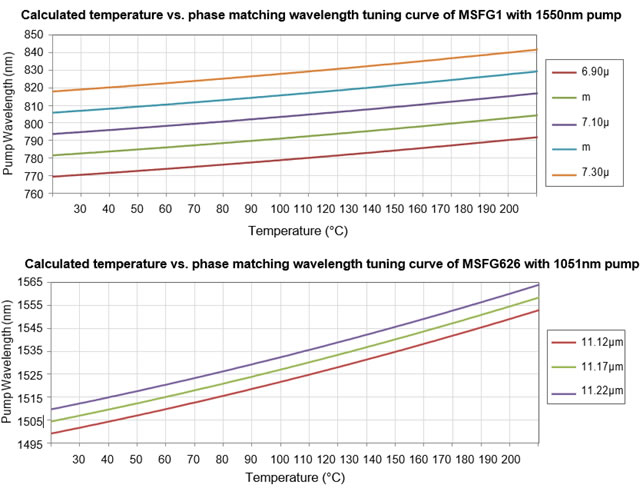
Custom MgO:PPLN for R&D to High-volume OEM
We provides a versatile basis for the design and manufacture of unique PPLN crystals. Our custom design and fabrication service provides application- specific technical consultation with specialist grating design and contract manufacture, resulting in a wavelength conversion solution tailored to your target laser system. We offer a range of custom design packages including:
one-off crystals
OEM prototyping
Large-volume manufacture
If our stock crystals do not meet your requirements, our engineering team is available to find the best crystal solution for your interaction. Our custom fabrication service involves consultation with the customer for design of the full grating layout, mask design, wafer poling, dicing, polishing and AR coating.
Your custom crystal can be designed to have a standard multi-grating layout, so that you can continue to use our temperature control systems, or your own unique design that is customised to your OEM laser system.
We can manufacture single crystals as small as <1mm3 for compact intra-cavity designs, or several millimetres wide aperture gratings with a long crystal length for high power applications.
Custom Designs for Non-standard Interactions:
PPLN crystals can be designed with aperiodic grating patterns to enable tailored spectral or thermal performance.
Periodic Custom designs:
Specific poling periods with custom AR coating
Specific poling periods with wider aperture
Non-standard length and custom aperture angles
Aperiodic Custom designs:
Linear period chirped gratings
Non-linear period chirped gratings
Please contact our design team to discuss your custom grating requirement.
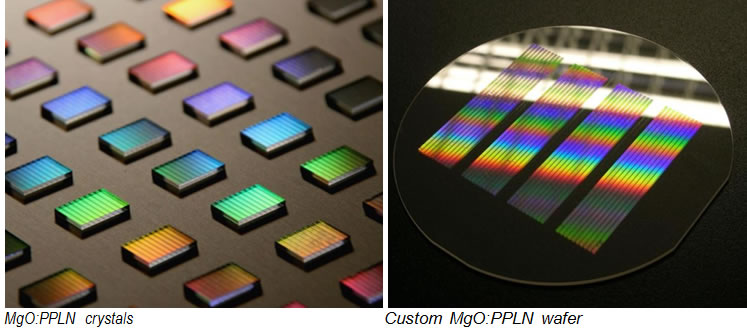
MgO:PPLN Applications
Chemical fingerprints can be identified for homeland security applications. PPLN devices are designed for efficient frequency conversion of lasers allowing you to reach wavelengths that cannot be achieved with conventional solid state lasers, diode lasers etc.
For example, you can use PPLN to:
frequency double a 1064nm laser to 532nm, a technique used for green laser pointers
convert 1064nm to 3µm, used for gas detection or microscopy imaging techniques
generate a narrow linewidth laser source for targeting a specific atomic transition for laser cooling and trapping.
Alternatively, PPLN has often been used to frequency double a high power tuneable 1550nm fibre source as a low cost and compact alternative to the Ti:Sapphire laser. Such a source can be used in microscopy systems for live-cell imaging, or terahertz time-domain spectroscopy where
PPLN devices are commonly used for high power mid-IR generation in an optical parametric oscillator. Tunable mid-IR systems are used in a wide range of microscopy imaging techniques as well as spectroscopy applications for environmental imaging. With pulse energies in excess of 1mJ, these mid-IR sources are also used in the defence industry for laser countermeasures and LIDAR systems.
Our MgO:PPLN has a wide range of applications:
Femtosecond Lasers§ THz generation§ Metrology § Frequency comb stabilization | Bio-Photonics§ CARS microscopy§ Fluorescence-based microscopy § DNA sequencing | Defence§ Laser countermeasures§ Trace gas detection LIDAR |
Green Lasers§ Laser projectors§ Seabed surveying | Quantum Optics§ Quantum computing§ Precision navigation systems | Aerospace§ Environmental monitoring§ Remote sensing Interferometry |
Examples:
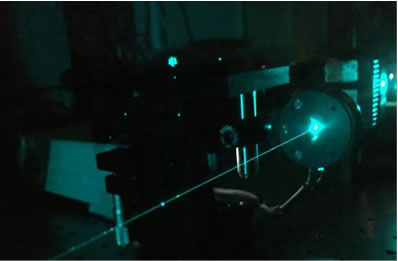
Picosecond cascaded frequency doubling with two crystals from 1952nm to 488nm. By Lin Xu, ORC, Uni. Of Southampton
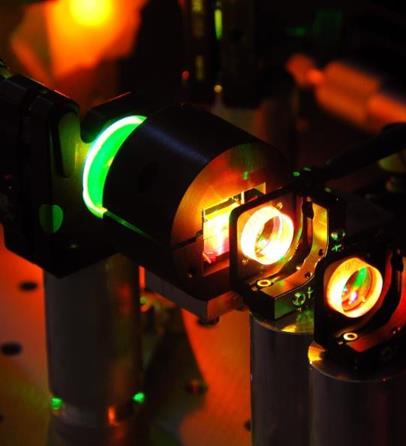
Nanosecond optical parametric oscillator for mid-IR generation Image courtesy of Elforlight 1952nm to 488nm By Lin Xu, ORC, Uni. Of Southampton
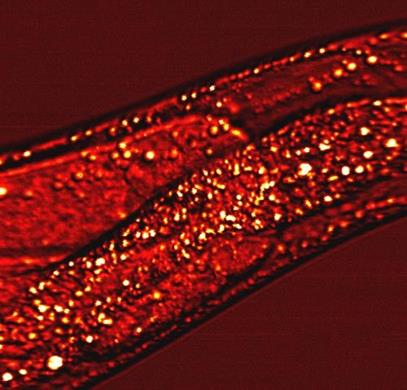
CARS microscopy image of elegans worm
PPLN ovens, Temperature Controllers and Accessories
Our optical engineers have designed a range of PPLN crystal clips, ovens, temperature controllers and mounting accessories, providing a complete PPLN system for easy integration into your optical arrangement.
Our PPLN clips are easily mounted into the oven using the auto-locating pins. These also allow the PPLN clips to be swapped in and out with negligible realignment of the optical train.
Several sprung pins in the oven top hold the PPLN crystal clip securely in place. The oven and PPLN crystal can then be mounted in any orientation, flexible to your choice of optical arrangement.
We recommends the OC2 temperature controller for high thermal PV oven series. The PV Oven Series is specially designed to provide secure mounting and robust thermal stability for our PPLN crystals.
Key Features:
Auto-locating dowel pins for alignment-free insertion
Temperature stability of ±0.01°C with OC2 controller
Various mounting options available
| Part number | Crystal length | Oven length | PPLN clip |
| STCS-PV10 | 1mm, 10mm | 22mm | PC1, PC10 |
| STCS-PV20 | 20mm | 32mm | PC20 |
| STCS-PV40 | 40mm | 53mm | PC40 |
| STCS-PV50 | 50mm | 62mm | PC50 |
PPLN clip kits:
The PPLN Clip Kits provide secure mounting of our PPLN crystals. All our crystals are supplied clip-mounted and ready for use in our ovens.
| part # | crystal length | oven length | PPLN clip |
| STCS-PV10 | 1mm, 10mm | 22mm | PC1, PC10 |
| STCS-PV20 | 20mm | 32mm | PC20 |
| STCS-PV40 | 40mm | 52mm | PC40 |
| STCS-PV50 | 50mm | 62mm | PC50 |
OC2 temperature controller
The OC2 temperature controller is a compact stand-alone benchtop unit for use with our PPLN oven range. The auto-detect feature provides hassle-free, plug- and-play functionality. The user can simply dial in the required temperature and allow the oven to reach optimum stability.
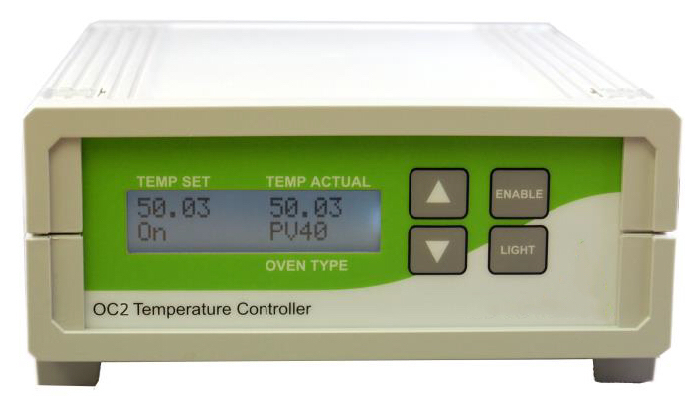
Key features:
Simple push button interface
Set point stability ±0.01°C
Set point resolution 0.01°C
Maximum temperature 200°C (250°C upon request)
PC control interface via USB
Auto-detect feature for all PPLN crystal ovens
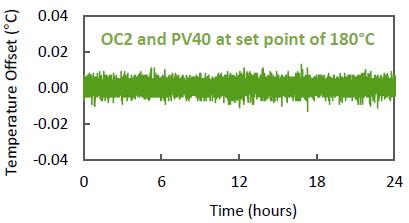
| Part number | Control range | Set point resolution | Stability | For ovens | Input |
| STCS-oc2 | Near-ambient to 200oC | 0.01 oC | +/-0.01 oC | PV10,PV20, PV40,PV50 | 90-240VAC 50-60Hz |
PC control:
Standard USB type B connector
OC2 software application
Data saved to .csv format
Features slow ramping via the Cycle Mode for finding SHG phase matching peak
LabView Drivers
PC control upgrade kit available for OC1 units: OC1-USB
Oven-free mounting solutions
| Part number | Description | Optical height |
| STCS-PCMO01 | Oven free PC01 clip mount adapter | 8mm |
Key features:
PC01 clip kit secured with two nylon tipped grub screws
M3 threaded hole
Each PCMO01 is supplied with an M3 to M4 thread adapter
Example mounting solutions:
M3 threaded hole allows fixture to Ø1/2” post assemblies
M3 to M4 thread adapter allows fixture to Ø1” post assemblies
M4 post assemblies can be fixed on to dovetail translation stages for alignment through all available gratings, as well as fine adjustment through a grating aperture
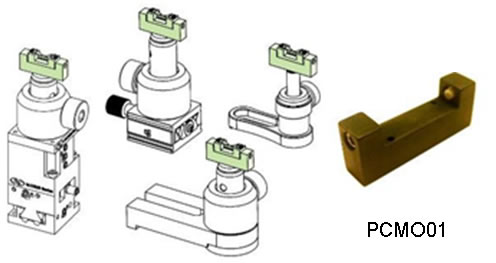
PPLN mounting example using PCMO01
Post mount adapters
| Part number | Description | Optical height |
| STCS-PVP1 | PV10 post mount adapter | 25mm |
| STCS-PVP2 | PV20, PV40 and PV50 post mount adapter | 25mm |
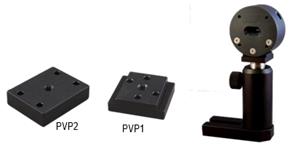
PPLN mounting example using PV10 and PV1
Flexure stage adapters:
Compatible with standard flexure stages and mounts from major optomechanics suppliers
PV oven and adapter have an optical height of 25mm above the flexure stage platform
Riser plate, RP12.5, increases the optical height of standard flexure mounts from 12.5mm to 25mm
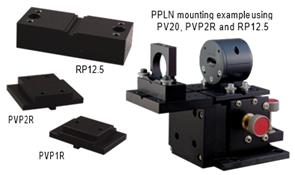
| Part number | Description | Optical height |
| STCS-PVP1R | PV10 adapter mount for flexure stages | 25mm |
| STCS-PVP2R | PV20 & PV40 adapter mount for flexure stages | 25mm |
| STCS-RP12.5 | 12.5mm riser plate for flexure stage mounts | 25mm |
PPLN Tutorial
We specialise in the manufacture of periodically poled lithium niobate (PPLN) devices, such as, MgO-doped periodically poled lithium niobate (MgO:PPLN or PPMgO:LN) and undoped PPLN. These PPLN devices are highly efficient mediums for nonlinear wavelength conversion processes, such as: second harmonic generation; difference frequency generation; sum frequency generation; optical parametric oscillation; and other second order nonlinear processes.
Principles:
Second order nonlinear processes (Fig. 1) involve the mixing of three electromagnetic waves, where the magnitude of the nonlinear response of the crystal is characterized by the χ(2) coefficient. Second harmonic generation (SHG), or frequency doubling, is the most common application that utilizes the χ(2) properties of a nonlinear crystal. In SHG, two input pump photons with the same wavelength λp are combined through a nonlinear process to generate a third photon at λSHG= λp/2. Similar to SHG, sum frequency generation (SFG) combines two input photons at λp and λs to generate an output photon at λSFG with λSFG = (1/λp + 1/λs)-1. Alternatively, in difference frequency generation (DFG) when two input photons at λp and λs are incident on the crystal, the presence of the lower frequency signal photon, λs, stimulates the pump photon, λp, to emit a signal photon λs and idler photon at λi with λi = (1/λp - 1/λs)-1. In this process, two signal photons and one idler photon exit the crystal resulting in an amplified signal field. This is known as optical parametric amplification. Furthermore, by placing the nonlinear crystal within an optical resonator, also known as an optical parametric oscillator (OPO), the efficiency can be significantly enhanced.
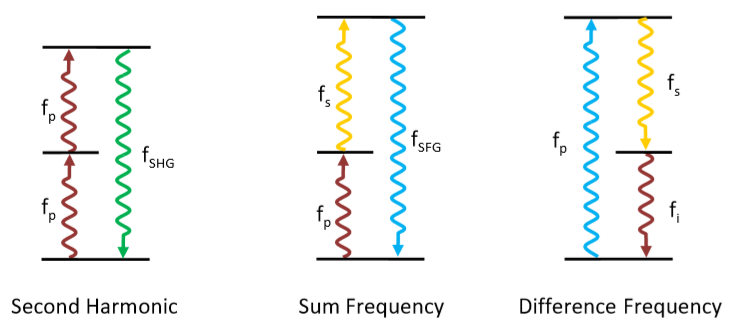
Fig. 1 Second-Order Nonlinear Interactions
Phase matching refers to fixing the relative phase between two or more frequencies of light as they propagate through the crystal. The refractive index is dependent on the frequency of light. Thus, the phase relation between two photons of different frequencies will vary as the photons propagate through the material, unless the crystal is phase matched for those frequencies. It is necessary for the phase relation between the input and generated photons to be maintained throughout the crystal for efficient nonlinear conversion of input photons. If this is not the case, the generated photons will move in and out put phase with each other in a sinusoidal manner, limiting the number of generated photons that exit the crystal. This is shown in Fig. 2. Traditional phase matching requires that the light is propagated through the crystal in a direction where the natural birefringence of the crystal matches the refractive index of the generated light. Despite providing perfect phase matching, this technique is limited to a small range of wavelengths in those materials that can be phase matched.
PPLN is an engineered, quasi-phase-matched material. The term engineered refers to the fact that the orientation of the lithium niobate crystal is periodically inverted (poled). By inverting the crystal orientation at every peak of the sinusoidal generation, one can avoid the photons slipping out of phase with each other. As a result, the number of generated photons will grow as the light propagates through the PPLN, yielding a high conversion efficiency of input to generated photons (Fig. 2).
The period with which the crystal needs to be inverted (the poling period) depends on the interacting wavelengths and the temperature of the PPLN. For example, a PPLN crystal with a poling period of 6.6μm will efficiently generate frequency doubled photons from 1060nm photons when the crystal temperature is held at 100°C. By increasing the temperature of the crystal to 200°C the same PPLN crystal will efficiently generate frequency doubled photons from 1068.6nm wavelength photons. Thus, changing the temperature of the crystal therefore varies the phase matching conditions, allowing some tuning of the wavelength interaction.
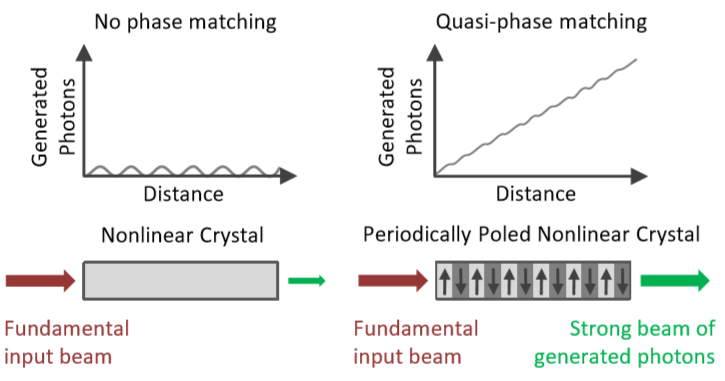
Fig. 2 Quasi-Phase Matching
Example uses of PPLN:
1. Optical Parametric Oscillator:
One of the most common uses of PPLN is in an Optical Parametric Oscillator (OPO). A schematic of an OPO is shown in Fig. 3. The common arrangement uses a 1064nm pump laser and can produce signal and idler beams at any wavelength longer than the pump laser wavelength. The exact wavelengths are determined by two factors: energy conservation and phase matching. Energy conservation dictates that the sum of the energy of a signal photon and an idler photon must equal the energy of a pump photon. Therefore an infinite number of generated photon combinations are possible. However, the combination that will be efficiently produced is the one for which the periodicity of the poling in the lithium niobate creates a quasi-phase matched condition. The combination of wavelengths that is quasi-phase matched, and hence referred to as the operation wavelength, is altered by changing the PPLN temperature or by using PPLN with a different poling period. Nd:YAG pumped OPOs based on PPLN can efficiently produce tunable light at wavelengths between 1.3 and 5μm and can even produce light at longer wavelengths but with lower efficiency. The PPLN OPO can produce output powers of several watts and can be pumped with pulsed or CW pump lasers.
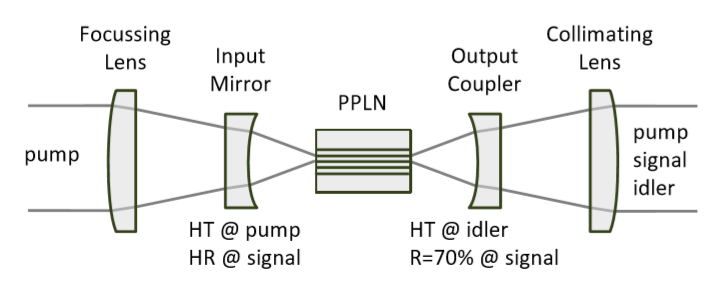
Fig. 3 Typical schematic of an OPO
2. Second Harmonic Generation:
PPLN is one of the most efficient crystals for frequency doubling and is well known for highly efficient green and red generation. It has been used to frequency double pulsed 1064nm beams with up to 80% conversion efficiency in a single pass pulsed system1. In CW systems, conversion efficiencies in excess of 50% have been demonstrated in an intracavity arrangement.
How to use PPLN:
Crystal length:
The crystal length is an important factor when choosing a crystal. For narrowband CW sources our longer crystal lengths, at 20 to 40mm, should give best efficiency. However, for pulsed sources, a long crystal can have a negative effect due to increased sensitivity to laser bandwidth and pulse duration. For nanosecond pulses, we typically recommend 10mm lengths and our shortest lengths at 0.5to 1mm are ideal for femtosecond pulse systems.
Polarization:
In order to access the highest nonlinear coefficient of lithium niobate, the input light must e-polarized, i.e. the polarization must be aligned with the dipole moment of the crystal. This is accomplished by aligning the polarization axis of the light parallel to the thickness of the crystal. This applies to all nonlinear interactions.

Fig. 4 SHG requires polarization parallel to the z-axis
Focusing and the Optical Arrangement:
Since PPLN is a nonlinear material, the highest conversion efficiency from input photons to generated photons will occur when the intensity of photons in the crystal is the greatest. This is normally accomplished by coupling focused light into the center of the PPLN crystal through the end face of the crystal at normal incidence. For a particular laser beam and crystal, there is an optimum spot size to achieve optimum conversion efficiency. If the spot size is too small, the intensity at the waist is high, but the Rayleigh range is much shorter than the crystal. Therefore, the size of the beam at the input face of the crystal is large, resulting in a lower average intensity over the whole crystal length, which reduces the conversion efficiency. A good rule of thumb is that for a CW laser beam with a Gaussian beam profile, the spot size should be chosen such that the Rayleigh range is half the length of the crystal. The spot size can then be reduced in small increments until the maximum efficiency is obtained. PPLN has a high index of refraction that results in a 14% Fresnel loss per uncoated surface. To increase transmission through our crystals, the crystal input and output facets are AR coated, thus reducing the reflections at each surface to less than 1%.
Temperature and Period:
The poling period of a PPLN crystal is determined by the wavelengths of light being used. The quasi-phase-matched wavelength can be tuned slightly by varying the temperature of the crystal.
The range of off-the-shelf PPLN crystals each include multiple different poling periods, which allow different wavelengths to be used at a given crystal temperature. Our calculated tuning curves give a good indication of the required temperature for phase-matching. The temperature dependence of conversion efficiency follows a sinc2 function, describing a crystal temperature acceptance bandwidth (Fig. 5). The longer the crystal, the narrower and more sensitive the acceptance bandwidth. In many cases the efficiency of the nonlinear interaction is very sensitive to within a few degrees Celsius.
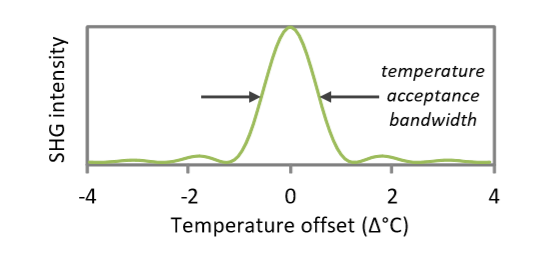
Fig. 5 SHG intensity temperature dependence for 1064nm pump in a 20mm long MgO:PPLN crystal
The optimum temperature can be determined by heating the crystal to e.g. 10°C higher than the calculated temperature and then allowing the crystal to cool whilst monitoring the output power at the generated wavelength.
Our PPLN oven is easy to incorporate into an optical setup. It can be paired with the OC2 temperature controller to maintain the crystal temperature to within ±0.01°C, providing highly stable output power.
MgO:PPLN vs undoped PPLN:
Undoped PPLN is usually operated at temperatures between 100°C and 200°C, to minimize the photorefractive effect that can damage the crystal and cause the output beam to become distorted. Since the photorefractive effect is more severe in PPLN when higher energy photons in the visible part of the spectrum are present, it is especially important to use the crystal only in the recommended temperature range.
The addition of 5% MgO to lithium niobate significantly increases the optical and photorefractive resistance of the crystal while preserving its high nonlinear coefficient. With a higher damage threshold, MgO:PPLN is suitable for high power applications. It can also be operated from room temperature up to 200°C, significantly increasing the wavelength tunability of the device. Moreover, in some special cases, the MgO:PPLN can be operated at room temperature and without the need for temperature control.
PPMgLN (Periodically Poled Magnesium Doped Lithium Niobate or called as PPLN) is an efficient nonlinear optical material for frequency conversion applications in the visible and mid-IR wavelength range.
PPMgLN material is widely recognized for these features:
High nonlinear coefficient
High conversion efficiency
Perfectly suited for compact low power solid state laser systems
High damage threshold and high efficiency
Excellent for small size, cost effective laser systems

We provide the following products:
1) Single PPLN element
2) PPLN for SHG: Second Harmonic Generation (SHG) is a nonlinear optical process whereby the pumping wavelength generates a new wavelength that is half of the input wavelength or double frequency. When using Nd:YAG wavelength 1064nm the SHG will become 532nm which is within the green light spectrum.
3) PPLN DFG: Difference Frequency Generation (DFG), generation of light with a frequency that is the difference between two other frequencies.
4) PPLN SFG: Sum Frequency Generation (SFG) is a non-linear optical process. This phenomenon is based on the annihilation of two input photons at angular frequencies ɯ1 and ɯ2 while, simultaneously, one photon at frequency ɯ3 is generated.
5) PPLN OPO: we provide the following types of PPLN OPO:
Standard DBAR coated for pump/signal wavelengths
Monolithic single pass and double pass
Confocal monolithic with convex/concave faces
A leading supplier and manufacturer of a wide range of photonics products such as lasers,laser parts & machines.
Office: 10 Bukit Batok Crescent #07-02 The Spire Singapore 658079
Tel: +65 63167112
Fax: +65 63167113
Whatsapp: +65 91904616
